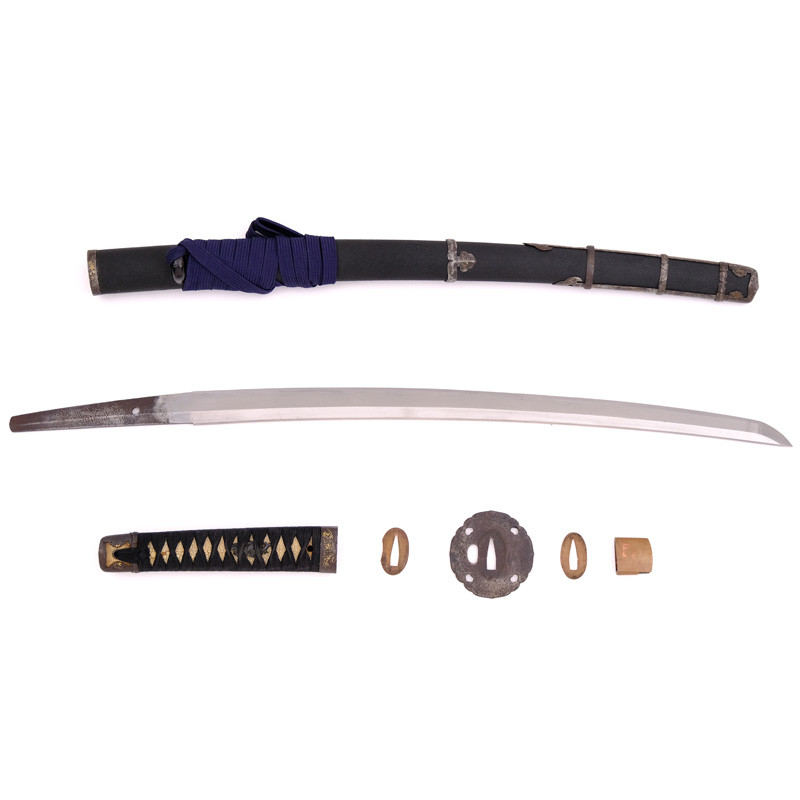












































More informations about this product
| Total Weight | 0.961 kg | |
| Weight without Saya | 0.758 kg | |
| Blade Weight | 0.494 kg | |
| Full lengthNaked Blade (Toshin) | 66.70 cm | |
| Nagasa | 51.30 cm | |
| Nakago Length | 15.40 cm | |
| Sori (curvature) | 1.30 cm | |
| Kissaki Length | 3.10 cm | |
| Moto Haba | 3.00 cm | |
| Saki Haba | 2.02 cm | |
| Moto Kasane | A = 0.55 cm B = 0.60 cm | |
| Saki Kasane | A = 0.42 cm B= 0.50 cm |
|
| Curvature | Tori Sori (central curvature) | |
| Type Kissaki | Chū Kissaki (medium length) | |
| Blade Structure | Zukuri: Shinogi Zukuri (diamond cut view) | |
| Mune | Iori mune (Triangular) | |
| Hamon | Hamon Ko Suguha in Ko-Nie, with Nijuba, Uchinoke and Kinsuji | |
| Hada | Ko-Itame thin and tight, with Mokume parts at the height of the Shinogi | |
| Boshi | Hakikake (brushed quenching line). | |
| Nakago | Ubu (unaltered), signed 越前國住包則 "Echizen Kuni Ju Kanenori" on Omote face, 1 Mekugi Ana, Futsu Gata shape, end in Ha Agari Kuri Jiri,Yasurime Katte Sagari. | |
| Saya | Saya Lacquer black mast (Kuroishime), weight 200g. Charcoal lacquer, fine and sparkling, Sageo in blue silk, Kurigata and Koiguchi in black horn. Complete Handachi assembly in steel with gold and silver border motifs and flower petals on Amaoi, Fuchi, Kuchigane, Shiba Biki, 3 Seme Gane, and Saya Jiri | |
| Tsuka & Tosogu (Tsuba, Menuki, Fuchi Kashira) |
- Tsuka: Weight 96g, length 19.50 cm, with black silk Handachi Zuka maki braiding. - Menuki: Menuki in Shakudo with leaves and bunches of vines design. Same white in good quality shagreen. - Fuchi & Kashira: Kashira (Kabutogane) from the Handachi Iron Set, with edging patterns and golden and silver flower petals. - Tsuba: Weight 116g, dimension 7.12cm x 7.41cm x 0.43cm. Aoi Gata shape, rounded border type Maru Mimi, Surface Muji (without relief). 4 openings in the shape of a boar’s eye (Inome), often also confused with a heart shape. Presence Kogatana Ana. - Seppa: 2 Single Copper Seppa (2x9g) - Habaki: Weight 27g, copper with light Kuri jiri pattern |
|
| Study & Team Review |
There have been 3 generations of blacksmiths named Echizen Ju Kanenori 越前住包則. This line originated from the Sanami 三阿弥 School of Mino, founded by Kanenori 兼則. It moved from Mino to Echigo during the Tenbun period (1532-1555). His eldest son, with the same name Kanenori 兼則, is considered the 2nd generation Kanenori 兼則, and moved to Echizen. It was part of the “Echizen-Seki” branch (越前関). This is when Kanenori 包則 1st generation appears, with kanji 包, who is none other than the younger brother of the second generation Kanenori 兼則. Kanenori 包則 1st gen, lived in late Momoyama (1573-1603) and early Edo period. His civil name was Shinpachi 新八, born in 1574 and died in 1642 at the age of 68. One can observe an evolution in his career, at first he forged in the Sue Seki style, then, in Echizen he worked in the style of the Yasutsugu lineage. His son, 2nd generation Kanenori 包則, apparently became married to the Echizen-Shimosaka branch (越前下坂). He then took the civil name Shimosaka Ichizaemon (下坂市左衛門) and was active from about 1635 to 1675. Affiliated with the Shimosaka branch, he worked with the Yasutsugu lineage for the Tokugawa Shogun. His blades are Wazamono-rated. Finally, the 3rd generation Kanenori 包則, active around 1685, who also worked in Edo and had the honorary title of Yamato No Daijo. The province of Mino experienced a significant boom during the Momoyama period and early Edo. This forging tradition was heavily solicited by the local lords and the blades were known for their durability and sharpness. North of Mino is the province of Echizen, where many blacksmiths settled over the years and especially after the battle of Sekigahara. After Sekigahara, this province was led by Matsudaira Hideyasu, 3rd son of the Shogun Tokugawa Ieyasu. In this province, there are 2 major blacksmith lines, “Echizen-Seki” (越前関) and “Echizen-Shimosaka” (越前下坂). The Echizen Seki branch was the first to establish itself in the Tenbun period (1532-1555), with blacksmiths from Mino such as Kanenori (兼法), Kanenori (兼 則) and Kanetsune (兼 常). All these blacksmiths from the Mino tradition have names of artists recognizable thanks to the kanji «Kane» used in the form 兼. There are other blacksmiths using another kanji «Kane» 包, referring rather to Kanenaga 包永, founder of the Tegai school in the Yamato tradition. This blade is a realization of the 1st Kanenori 包則 generation, Shinpachi, at the beginning of the Edo period. We appreciate the very sober, fine and elegant warrior quenching line. The Handachi assembly is also sublime. The steel parts, old, allow to see gold and silver borders finely affixed. Kuroishime charcoal lacquer gives a very fine and slightly shimmering granulated effect. |
|
Share your opinion
error Your review appreciation cannot be sent
feedback Report comment
check_circle Report sent
error Your report cannot be sent